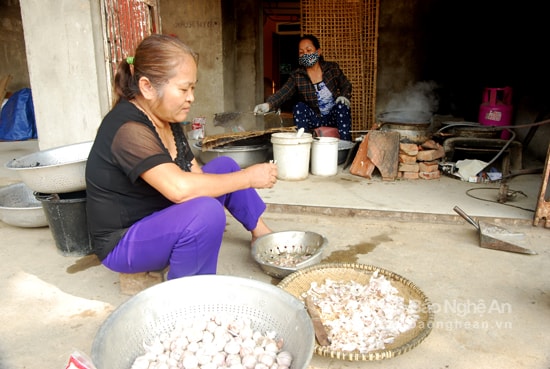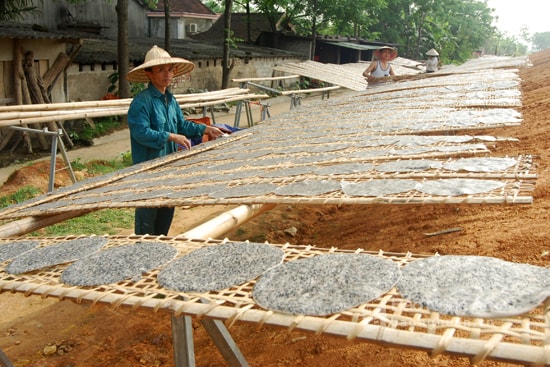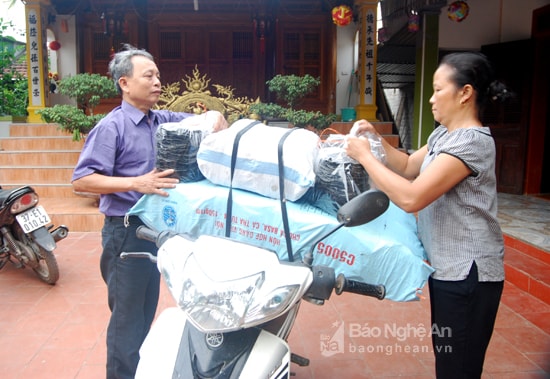Keeping the rice paper craft village in Thanh Chuong alive
(Baonghean.vn)- Vinh village, Thanh Tuong commune (Thanh Chuong) has long been famous for its traditional rice paper making. Rice paper has delicious quality not only in the province but also favored by customers in many regions.
For more than 43 years, Mrs. Nguyen Thi Binh in Hamlet 4, Thanh Tuong Commune (Thanh Chuong) has been waking up at 3 a.m. to make rice paper, a profession passed down for many generations that is being preserved and developed by her and many other people.
Ms. Binh said that making rice paper requires staying up late, waking up early and only doing it when it is sunny, the stronger the sun the harder it is. In addition to the weather factor, this profession also requires many technical factors from the stages of selecting rice, grinding flour, adding spices, spreading, and drying. The rice paper here is made from Khang Dan rice, after soaking for a few hours, the rice is put into a small grinder; in the past, this was the most labor-intensive step because it had to be ground with a stone mortar. After grinding, the rice is mixed with black sesame, spices, pepper, garlic, seasoning powder, MSG...
For every 10 kg of rice, mix 3 kg of sesame, the spices are adjusted according to each professional's secret recipe. Another requirement that requires technique is the thickness or thinness of the batter when spreading the cake. If the batter is too thick, it will be difficult to spread, if the batter is too thin, the cake will be thin.
 |
| For every 10 kg of rice, mix in 3 kg of sesame. The spices are adjusted according to each professional's recipe. Photo: Tran Dinh Ha |
Every day, the craftsmen get up at 3am to soak the rice, grind the flour, and at 6am start making the cakes. Then they are put out to dry, about 1 hour later they have to turn them, after 4-5 hours they are dry. If the cakes are dried too much, they will be brittle, easy to break, and difficult to flatten. If they are not dried enough, the cakes will easily get moldy. After drying, the cakes are left on the tray, stacked on top of each other, pressed with a heavy object for a few hours to flatten, then removed, stacked and packaged.
According to Ms. Nguyen Thi Loan - a famous artisan of the craft village, Vinh village rice paper is not only consumed in the province but also sold in many provinces and cities across the country, including abroad. Customers in each region have their own preferences; for example, Vinh customers require a diameter of about 18 cm, customers in the Northern and Southern provinces prefer larger rice paper (from 20 - 22 cm), so every day, in addition to making rice paper, we also have to balance orders to meet customers' needs.
 |
| After coating, the cake must be put out to dry in the sun immediately; after drying for about 1 hour, the cake must be turned over so that it dries evenly. Photo by Tran Dinh Ha |
On average, a bakery produces about 2,500 - 3,000 cakes per day, after deducting costs, the profit is about 1,000 VND/cake. Although the profit is not high, in the hot summer, you can make a lot, the rice paper making profession also contributes to increasing income.
According to Mr. Luu Van Hoa - Chairman of Thanh Tuong Commune People's Committee: Currently, in Vinh village, there are 51 households with 170 workers specializing in making rice paper. They are the ones who keep the fire burning for the craft village, creating the main income for the village. From rice paper, households have built spacious houses, raised their children to study and grow up.
 |
| Vinh village rice paper is sent by passenger buses to customers across the country. Photo by Tran Dinh Ha. |
Based on the tradition and production results of the village, in 2006, the People's Committee of Nghe An province decided to recognize the craft village of Vinh village's vermicelli and cake in Thanh Tuong commune. However, in the market mechanism, the craft village is facing many challenges. In fact, it has been consumed everywhere but still spontaneously, the product does not have a stable market.
Since being recognized as a craft village, the government and functional agencies at all levels have not provided any support, mainly due to the initiative of the craftsmen themselves. Thanh Tuong rice paper craft households are in need of investment in factories and support in building product brands to be able to "keep the fire" of the craft.
Tran Dinh Ha


